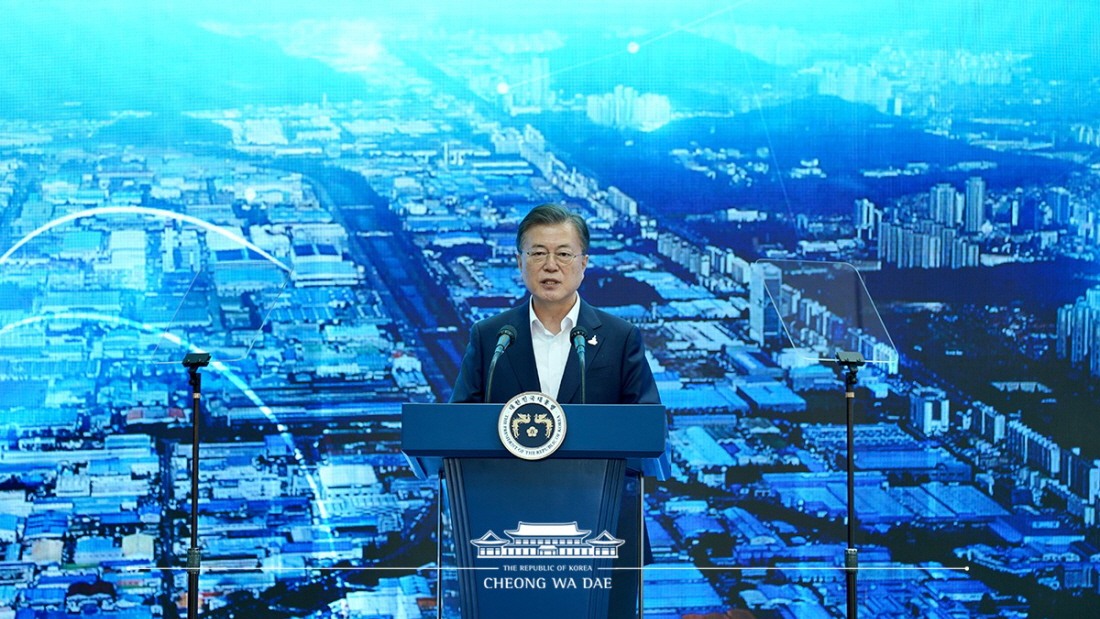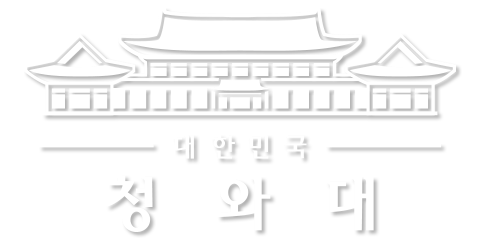이 웹사이트는 제19대 대통령 임기 종료에 따라 대통령기록관이 「대통령기록물 관리에 관한 법률」에 의해 이관받아 서비스하는 대통령기록물입니다. 자료의 열람만 가능하며 수정 · 추가 · 삭제는 불가능합니다.
다만, 「개인정보보호법」에 의하여 개인의 정보를 보호받기 원하시는 분은 관련 내용(요청자, 요청내용, 연락처, 글위치)을 대통령 웹기록물 담당자(044-211-2253)에게 요청해 주시면 신속히 검토하여 조치해 드리겠습니다. 감사합니다.
SPEECHES & REMARKS
BRIEFINGS

Fellow Koreans, residents of Gyeongsangnam-do Province and Changwon City,
We have to prevail over COVID-19 and, at the same time, preserve the economy. We have to achieve even greater prosperity with a new economy, not simply recover from the current difficulties.
The Changwon National Industrial Complex is transforming into a smart green industrial complex, becoming a symbol of the Korean New Deal. Today in Changwon, I can see hope for the Republic of Korea’s economy in the post-COVID-19 era. I would like to make our people aware of the progress that is being made in the Korean economy even amid the hardships stemming from the COVID-19 pandemic.
The world is now making responsive preparations for the post-COVID-19 era while keeping “digital” and “green” in focus. Here in Korea, Changwon is getting a head start along these lines. If an industrial complex can increase productivity through data, network, and artificial intelligence technologies while reducing environmental contamination through clean energy sources, it will be credited with tremendous innovation. That tremendous innovation is happening in Changwon. A smart green industrial complex, it is simultaneously bringing about the “digital economy” and “low-carbon economy.”
These smart green industrial complexes will become our strategy for innovative manufacturing that transforms Korea’s economic model from that of a fast-follower to a pace-setter. It will also become our economic compass and a balanced national development strategy to resuscitate local economies.
I wholeheartedly applaud and encourage the residents of Gyeongsangnam-do and Changwon, the local businesses, Provincial Governor Kim Kyoung-soo and the relevant officials taking on this bold challenge.
Residents of Gyeongsangnam-do and Changwon,
The Government has so far devised an SME manufacturing innovation strategy and a manufacturing renaissance strategy. It has also worked hard to increase the number of smart factories and create smart industrial complexes. Industrial complexes in seven cities, including Changwon, Banwol, Sihwa, Namdong and Gumi, have been designated as smart industrial complexes. Moreover, the Government and businesses have pulled together to build over 16,000 smart factories.
The Changwon National Industrial Complex, together with those in Banwol and Sihwa, has been selected as Korea’s first leading smart industrial complex. The complex and the 260 smart factories it houses are at the forefront of the convergence of manufacturing and the IT industry, creating a new service industry. It is rapidly transforming itself into a 21st century industrial complex, moving from a space for production to one for innovation.
Today, at the smart factory of Taelim Co., Ltd, I saw a robot use two arms to produce goods and data analysis being used for quality control. I have also heard welcome news that Taelim has seen its exports rise in the course of enhancing the trust of overseas buyers, which has helped it hire more employees. In this way, the company has shattered the prejudice that smart factories would wipe out jobs.
Businesses in Gyeongsangnam-do that adopted smart factories, like Taelim, saw their sales and exports increase by more than 22 percent on average, and job opportunities also increased by 2.6 percent. Branches of the Korea Electronics Technology Institute (KETI) and Korea Automotive Technology Institute (KATI) have been established in Gyeongsangnam-do, and large businesses and IT firms equipped with smart factory-related technologies have decided to invest and gather here in the southeastern part of the country.
Thanks to these developments, youth who once looked to the Seoul metropolitan area for job opportunities can now achieve their dreams in other areas. The young in provincial areas are emerging as the main players in regional development through the project to foster human resources based on cooperation among business, academia and research institutes. This will also be of immense help to innovative manufacturing in Busan, Ulsan and Gyeongsangnam-do.
Fellow Koreans,
Smart green industrial complexes represent a new competitive edge in the post-COVID-19 and climate change eras. They will help reduce energy consumption and environmental pollution through digital technologies and increase jobs along with the growth of new renewable energy and other novel industries.
Industrial complexes consume 40 percent of our country’s total energy. Transitioning to green industrial complexes for environmental preservation is a must, not an option. The Government will further enhance the Korean economy’s competitiveness through smart green industrial complexes, which surpass smart industrial complexes. By 2025, all seven smart industrial complexes will be converted into smart green industrial complexes. This will help increase their output by 12.3 trillion won and create 33,000 new jobs. To this end, we will formulate three strategies and invest a total of 3.2 trillion won.
First, we will further accelerate the digitalization of industrial complexes and upgrade our flagship business sectors. By 2025, we will raise the penetration rate of smart factories in industrial complexes to 20 percent from the current 5 percent. We will establish an innovation data center – a data dam for an industrial complex – to help improve product quality and the manufacturing process through AI technology.
The Government will introduce smart logistics platforms, including self-driving shuttles and unmanned, specially equipped vehicles and significantly reduce safety accidents through integrated logistics control systems. We will boldly ease limits on the types of businesses at different industrial complexes. We will also nurture intelligent robots, future cars, bio-health, 5G and other new state-of-the-art industries as core business sectors in industrial complexes by applying regulatory sandboxes.
Second, we will promote the use of low-carbon, highly efficient energy. We will completely eliminate pollutants during the manufacturing process by establishing a total of 700 clean factories. We will also cultivate new eco-industry development projects in which waste products are recycled as raw materials for other companies.
We will expand the use of clean energy such as hydrogen power plants and natural gas and push ahead with plans for the RE100 pilot project that will manufacture goods entirely through new renewable energy. Mass-transit buses will be replaced with those powered by hydrogen or electricity. We will also provide individual factories with energy management systems, thereby saving energy through data-based demand management. Energy efficiency will rise more than 15 percent by 2025, and the portion of new renewable energy-based power generation at industrial complexes will increase from 0.6 percent to 10 percent.
Third, we will help increase mutually beneficial local jobs. People are the key to success at smart green industrial complexes. We will nurture talented AI and big data specialists by cooperating with local universities. We will build cultural complexes, beautiful streets – pleasant walkways – and public housing for young adults to rent, thereby creating environments in which everyone wants to work and live. I am looking forward to more local jobs being created for talented individuals through regional, mutually beneficial employment.
Fellow Koreans, residents of Gyeongsangnam-do and Changwon,
It was not until the 1960s that we began to build industrial complexes to catch up with the West’s level of industrialization. However, in just half a century, Korea has become the world’s sixth-largest manufacturer and joined the ranks of its top ten economies.
The Republic of Korea is no longer that country from the past. As an IT powerhouse, we are spearheading the green economy through, for example, hydrogen-powered vehicles. We are leading the world not only in Hallyu and the film and television industry but also in epidemic prevention and control.
Smart green industrial complexes – a symbol of the Korean New Deal – will play a leading role in the post-COVID-19 era “K-economy.” The enthusiasm for smart green industrial complexes that started in Gyeongsangnam-do will spread throughout the country and provide new hope for local economies as well as the Republic of Korea’s economy.
Now, local areas are the main drivers of innovation. The Government will run vigorously with Changwon, Gyeongsangnam-do and smart industrial complexes throughout the country.
Thank you.



